IIn the winter of 2008, Ricardo (Rico) Pereyda prepared for his final mission with military precision. Behind the walls of his boyhood home, Pereyda placed blankets on the floor of his old bedroom. He wrote a letter of apology to his estranged wife and his parents, June and José. Then he lay on the floor, cocked a 9 mm handgun, placed the barrel of the weapon in his mouth and rested his finger on the trigger.
Pereyda hadn’t been himself since returning from combat in Iraq. A member of the U.S. Army Military Police Corps, he and his comrades performed dangerous security missions in Baghdad, Fallujah and elsewhere in and around the region’s Sunni Triangle. Pereyda’s platoon operated at a “high ops tempo,” the military term for a relentless pace of deployment. Teetering on the bleeding edge of war, Pereyda did his job and hung on. From February 2004 through March 2005, he encountered improvised explosive devices (IEDs), ambushes, mortar attacks and firefights. He bore witness to death and suffering at close range.
“It was a hellish, violent year, far beyond anything I ever experienced in the streets,” says Pereyda, who grew up poor in Tucson, Ariz. “You name it, we got hit with it.”
The unrelenting assault shattered Pereyda’s psyche. Once back in the States, he began having panic attacks. Pereyda sought relief in drugs, alcohol and isolation. “It was a miracle if I could get out of the house,” he says. “I would get panic attacks just thinking about going outside. … I had an enemy inside.”
His wife left him, and he lost his house. With nowhere else to go, he moved back home.
Lying on the blankets, he shifted the handgun from his mouth to his temple and back again. Unable to fire the final round, he flung the weapon across the room, curled into a ball, and sobbed. He couldn’t bear the thought of his parents finding his lifeless body.
You go from a (military) bureaucracy that tells you everything to do to a (higher education) bureaucracy that doesn’t tell you anything to do — it’s a night-and-day shift in structure. – Matt Randle, Army Reserve veteran and University of Arizona graduate
In the span of four years since that day, Pereyda has become a new man. In May he graduated from the University of Arizona with a bachelor’s degree in public management and policy (with an emphasis on criminal justice and a minor in military science and leadership). He is the first person in his family to earn a four-year credential. He has received offers of jobs and internships.
Some 2 million men and women in uniform have returned or will return home in the next few years. Like Pereyda, many are veterans of deployments to Iraq and Afghanistan. As those wars draw to a close, hundreds of thousands of soldiers, airmen, sailors, Marines and members of the National Guard will enroll in college, enticed by education benefits provided by the post- 9/11 G.I. Bill and other programs for veterans. College is an opportunity for them to reclaim and get on with their lives.
Yet the outlook can be as unclear as a battlefield enshrouded in the fog of war. A significant number of student veterans suffer from post-traumatic stress disorder (PTSD), traumatic brain injury and other disabilities. Not all come to the desperate crossroads that Rico Pereyda reached, of course, but none of these veterans emerges unaffected. Most haven’t been in a classroom for years. Almost all will struggle at times to negotiate the tricky transition from one distinct culture to another. For these warrior scholars, a college campus is a minefield.
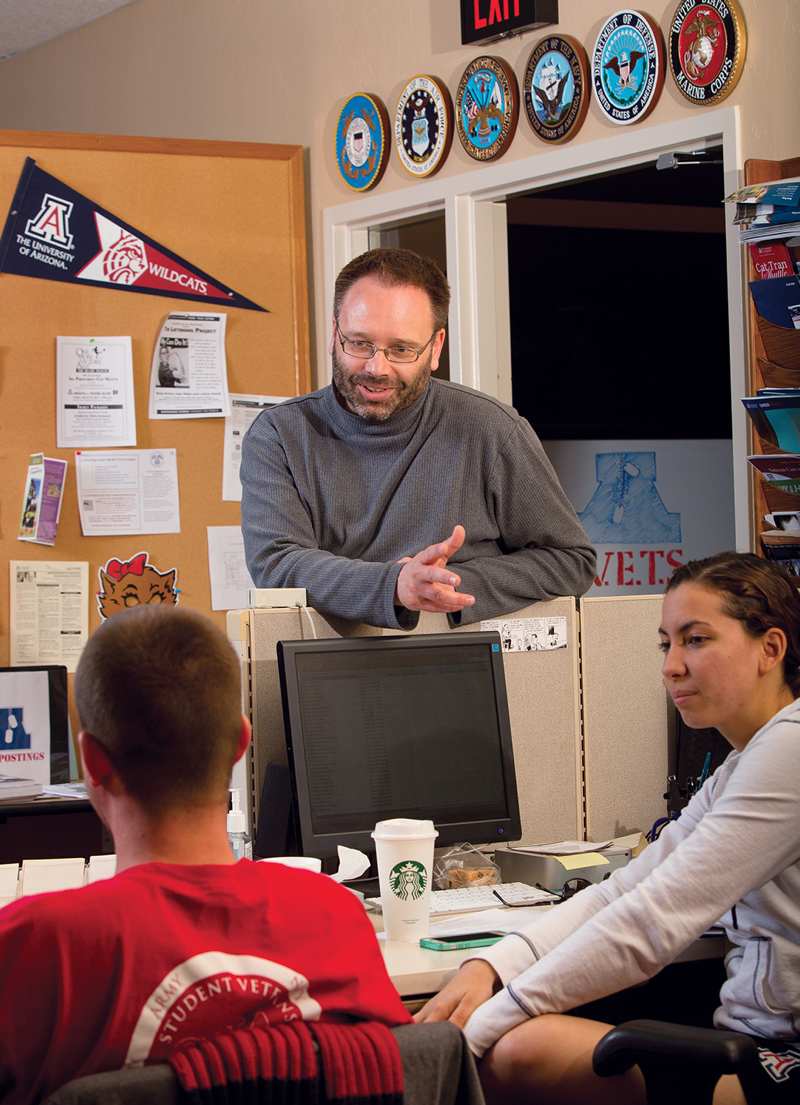
“You go from a (military) bureaucracy that tells you everything to do to a (higher education) bureaucracy that doesn’t tell you anything to do,” says Cody Nicholls, 39, the University of Arizona’s assistant dean for Veterans Education and Transition Services (VETS). “It’s a night-and-day shift in structure.”
Colleges and universities are taking steps to clear the tripwires that imperil members of the at-risk veteran population. A few institutions have moved faster and more deliberately than most. The ones that have had the most success are those that have put in place comprehensive programs involving departments and offices across their campuses.
It isn’t an easy undertaking. The relationship between colleges and student veterans is complex and evolving — with potentially huge benefits for both parties. Student veterans “bring diversity of a type that higher education says it desires,” says Michael Dakduk, executive director of Student Veterans of America. Formed in 2008, the not-for-profit group is a network of more than 750 campus-based chapters that work to develop “the resources, support, and advocacy” that military veterans need to succeed in higher education and beyond.
The emergence of veteran-friendly colleges and universities also raises a question of broader significance: If institutions can implement comprehensive programs that help student veterans succeed, can they help unravel the complex array of challenges that bedevil other at-risk groups? First-generation college students? Minorities? Students from low-income families? Students suffering from substance abuse? Students with mental or emotional challenges?
“If we can get this right for vets, we can get it right for all students,” Dakduk says.
‘I didn’t like college kids’
Growing up on the south side of Tucson in the 1990s, Rico Pereyda was a self-described troublemaker who was bored with school. College seemed unattainable and undesirable. “I knew I couldn’t afford it, and I didn’t like college kids,” says Pereyda. “It wasn’t in my future. I didn’t picture myself in college.”
Having been kicked out of several schools, he dropped out in 1999, his sophomore year, and took a job on a construction crew with his father. “I was happy working with my hands in the sun,” he says. Then came the terrorist attacks of Sept. 11, 2001. Pereyda quit his job to enlist in the military. A Navy recruiter turned him away, however, citing Pereyda’s failure to complete high school.
Determined to serve his country, Pereyda earned a diploma and enlisted in the Army. He survived boot camp and joined the 554th Military Police Company, based in Stuttgart, Germany. His platoon, the 230th MPC, deployed to Iraq.
Looking back on it, Pereyda says his descent into hell likely started on a day when everything went wrong. His platoon had been rerouted from its scheduled mission and ordered to guard a convoy of gas tankers that had been disabled in an attack. While on guard, he and his men fired on an insurgent truck driver who had failed to heed warning signals. Pereyda stuffed the man’s many wounds with gauze and loaded him into an evacuation helicopter. In a second shooting that same day, a 50-caliber round sheared off the side of a local man’s face — in full view of his grandson. Later, a Molotov cocktail transformed the disabled tankers into “infernos.” Before the day was out, Pereyda had learned that a buddy had been injured — a buddy whose platoon had taken the mission from which Pereyda’s had been diverted. The soldier had been hit by chunks of burning shrapnel that “lodged in his right temple, popped out his eye and nearly cleaved his arm.”
That horrible day was one of many for Pereyda. In fact, midway through his tour of duty, Pereyda’s platoon had lost half its men. And the fallout from those losses didn’t end when the tour did.
After he returned home to Tucson, Pereyda’s panic attacks worsened. “I knew I had to do something to get out of the house,” he says. His solution, in 2005, was to enroll at a local community college. When a biology instructor gave him a study sheet intended to help students prepare for the first exam, Pereyda assumed it was a comprehensive overview of the type he had been given in advance of military tests. He was dismayed to find that the exam included questions not covered by the guide.
“I looked at it as the professor setting me up for failure,” says Pereyda, who bolted the classroom without completing the exam. “That’s how I started in the academic world.”
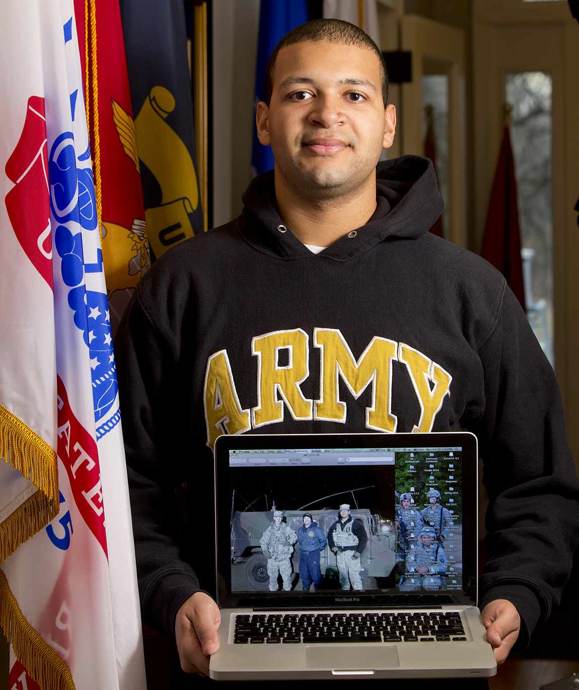
In 2009, Pereyda’s circumstances began to improve. A Veterans Affairs (VA) counselor who had worked with him for several years suggested that he check out the University of Arizona. The institution had recently established veterans programs designed to help students like Pereyda to reach their education goals. There was even a new veterans center, a modest outpost that occupied a tiny room in the Old Main building. If you put half dozen people in the center, “it was packed,” Nicholls recalls.
Despite Pereyda’s misgivings, he began taking classes in the spring of 2010. “I never dreamed I would be coming here,” he says. “I was a very nontraditional student — in every sense of the word.”
Veterans center is crucial
Creating veteran-friendly campuses requires high-level administrative support, buy-in from faculty and staff, and accommodations that make campuses more accessible to student veterans. Successful programs typically feature an on-campus coordinator of student-veteran programs and veteran-specific orientations for new students. To be most effective, those elements must be embedded in an institution’s infrastructure, says SVA’s Dakduk.
Perhaps the most critical aspect of veteran-friendly colleges and universities is having a place on campus where student veterans can congregate and gain access to vital resources, according to Dakduk and others. Pereyda says Arizona’s veterans center was a second home, a place where he studied, fraternized and did volunteer work. Without it, he likely wouldn’t have made it to graduation.
“I was very much a raw nerve,” says Pereyda of those first weeks and months on campus. He likens his initial experience at the university to jumping off a high dive into an ocean of 40,000 students. “Talk about the deep end. … I clung to the veterans center.”
For many of the approximately 1,000 University of Arizona students who have served in the military, a chasm seems to separate them from their non-veteran peers. The age difference alone can be significant, of course. But as the saying goes: It’s not just the age, it’s the mileage. Traditional college students are away from home for the first time and eager to gain a measure of worldliness; veterans who have deployed multiple times to war zones halfway around the globe can be world-weary. A traditional college student might be concerned about conflicts with a roommate, while “a housing issue for us is somebody becoming homeless,” says Nicholls, an Army Reservist who served in Iraq and Kuwait. “We’ve had veterans camp out on a sofa (at the veterans center) until they get back on their feet.”
Most important, the centers are places where veterans make connections with men and women they can trust because they have “walked in the same boots,” Nicholls says. “Trust is a big thing for veterans. When you’re walking down the streets of Fallujah, you don’t know who is friend or foe.”
Pereyda met men and women at the veterans center who shared his experiences. “What helped me was another veteran saying, ‘C’mon, you can do it,’” he says. Two of these encouraging voices were those of Dan Standage and Matt Randle — two veterans who had made the transition years earlier and are now focused on easing the path for others.
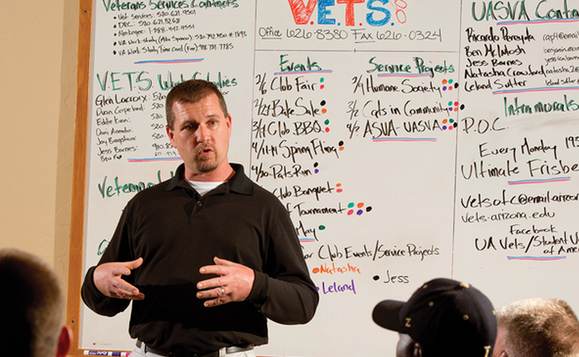
Standage grew up in Arizona in a family of eight kids. On Veterans Day 1990, his senior year of high school, he enlisted in the Marine Corps. It was “a calling,” he says. The following spring he earned a high school diploma, becoming one of only two siblings to do so. “We were expected to work for my dad,” Standage says. “We were never expected to graduate.”
In Okinawa, Standage married and had two sons. A routine vaccine for Japanese encephalitis caused a rare reaction that destroyed Standage’s optic nerves. Having served his country for a decade, Standage returned home in 2001 — blind, divorced and with custody of his sons. Years of despondency followed. In 2004 he gained admittance to a VA rehabilitation center for the blind and began the process of reclaiming his life.
The center’s leaders offered Standage a job but rescinded it when they learned that he lacked higher education credentials. His second wife, whom he had met at the center, discovered that his disability qualified him for vocational rehabilitation education benefits, and Standage enrolled at the University of Arizona.
He was grateful to be in college, but frustrations mounted. Lack of public transportation meant that Standage was “stuck at the library” for long periods each day. He was “ticked off (and) antisocial,” he says. The experience wasn’t unique. If anything, it was an extreme version of the disorientation experienced by thousands of men and women who arrive at the university each semester. “Every new student who comes to this campus is blind,” he says.
Standage persevered, though, and in 2008 he became active in the growing national movement to create veteran-friendly college campuses. He began to understand the power of role models. “When I saw a blind guy struggling and going to college, I knew I could do it too,” he says. “Vets with disabilities need to see other vets with disabilities who are successful.”
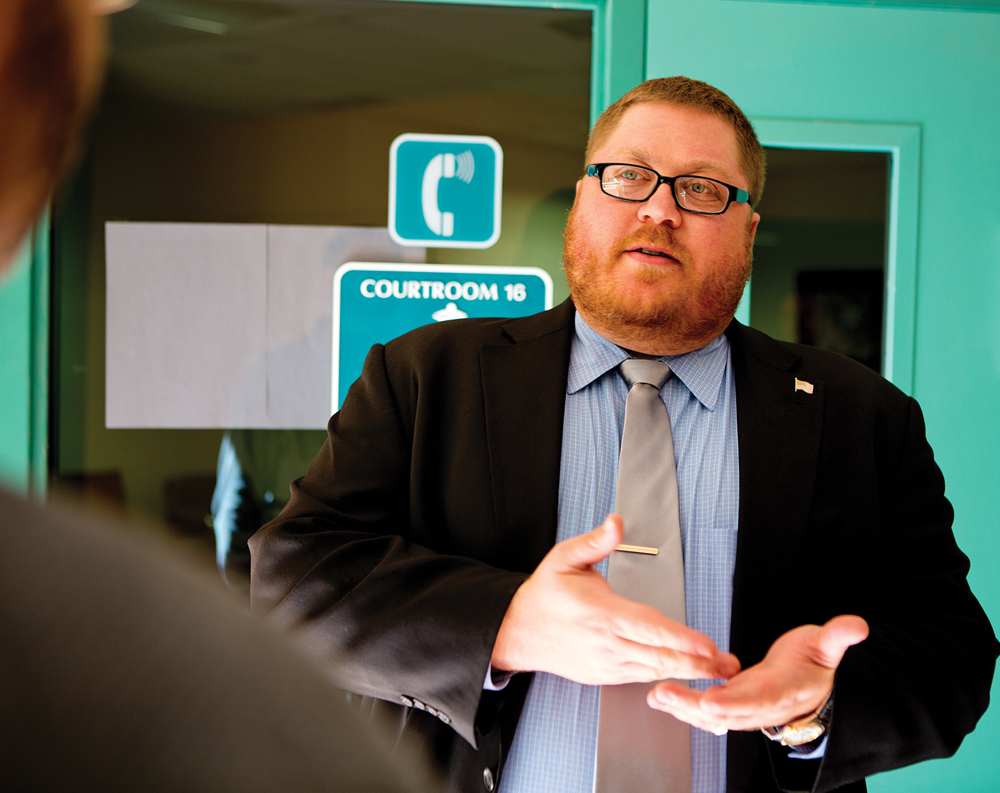
In high school, Matt Randle was the kid labeled “college material.” Selected for gifted programs, Randle served on the student council and made the football and wrestling teams. Fascinated with history and the military, he yearned to be “part of something bigger.”
In 1998, on his 17th birthday, Randle enlisted in the Army Reserve. He completed basic training during the summer after his junior year and became an active-duty soldier following graduation. In 2003, he was part of the force that invaded Iraq.
Combat was “the very best … and the very worst,” recalls Randle, 32, who served as a medic. “The friendship, camaraderie, brotherhood and family I had over there compares to nothing else. … (But) I lost friends over there. I saw humanity at its ugliest, human life at its least valuable. There’s no way to adequately prepare oneself for that.” He was among the first wave of soldiers to return from fighting in Iraq. He came home suffering from PTSD, “a non-visible disability, one that not many people in higher education have been exposed to.”
At his first step in higher education, a community college near his home, Randle encountered a college that was not ready to support student veterans. “They didn’t even know how to process my G.I. Bill,” he says.
For two years he took classes alongside 18-year-old kids with whom he had nothing in common. Randle posted a 3.9 grade point average, yet he felt unmoored. “I got fed up. I was lost. I was angry. I wasn’t going to school for any other reason than I thought that that was what I was supposed to do,” says Randle, a burly, bearded redhead with eyes hidden behind sunglasses. “I felt like a foreigner in my own home. I felt like an alien.”
Across the veteran population, we do an amazing job of taking care of each other and a piss-poor job of taking care of ourselves. – Cody Nicholls, Assistant dean, University of Arizona
When his father died, Randle moved home to help his mother, who works for the University of Arizona. He found a job doing advocacy work on behalf of veterans, which he enjoyed. Opportunities for advancement arose, but Randle lacked a degree. “I hit a wall,” he says. “I couldn’t move further in my career.”
In the fall of 2008, Randle enrolled for a single course at the university, encouraged by then-President Robert Neal Shelton. “The president of the university sought me out,” recalls Randle, sounding incredulous more than four years later. “If you have earnest support from the top, you can move mountains.”
In 2011, Randle earned a bachelor’s degree in family studies and human development. He married and enrolled in law school. He expects to graduate in May 2014. “I hope to continue to serve,” he says. “I would like to run for office.”
‘Friendlies’ dot the campus
In many ways, Randle and Standage got through college the hard way. Prior to 2008, the University of Arizona had no programs for promoting veterans’ success. Since then, it has advanced toward President Shelton’s goal of becoming the most veteran-friendly university in the country. The university created the VETS program, which draws on assets from across campus to support men and women who served in the military.
You’ll find stalwart supporters of veterans in the registrar’s office and the offices of admissions and financial aid. They show up at the disability resource center and at health services. Student veterans call them “friendlies.”
“Parts of this campus are incredibly helpful,” says Randle. “Parts are less aware of the help they could give.”
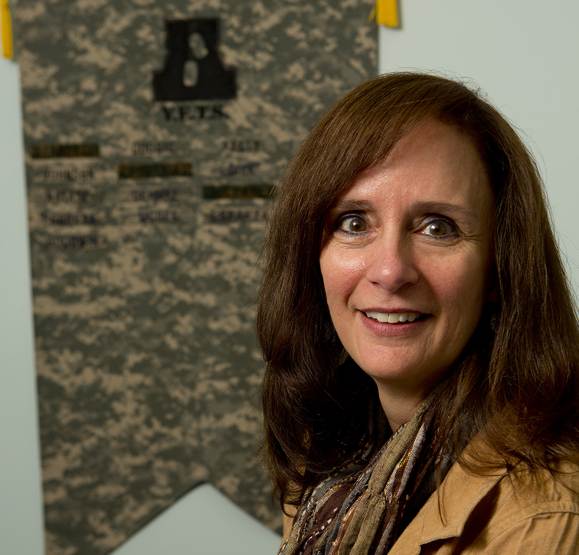
Maralynn Bernstein, a veteran services coordinator in the Office of the Registrar, is a friendly. Some student veterans know her as Mama Bear. A few years ago, she realized that the customer service her office was providing vets “wasn’t what it should be.” Drawing on her background in retail sales, she revamped the office and became an advocate for student veterans. One goal was to make sure that the university’s vets understood government education benefits that can be “extremely complicated.”
“There is really bad information out there,” says Bernstein, recalling a veteran in medical school who thought he had used all of his benefits to earn an undergraduate degree. Bernstein investigated and found a provision in the law that allowed this student an additional 12 months of benefits — a $26,000 discovery.
“It was like the coolest thing ever,” she says. “If they don’t have to worry about where their money is coming from, they can focus on their studies.”
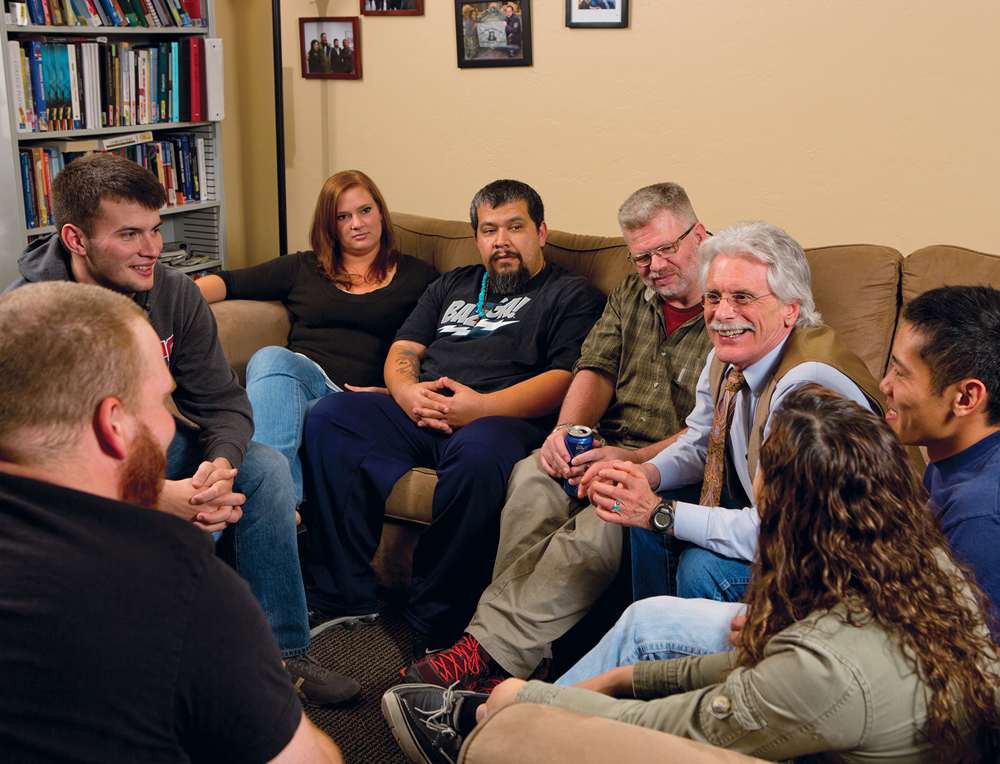
Another “friendly” on campus is Michael Marks, lead psychologist for the Southern Arizona VA Health Care System. Acclimating to civilian life is an arduous process that receives too little attention and too few resources, he says. It takes about a year for enlistees and newly commissioned officers to adjust to military life. The notion that three days in a military transition program will prepare vets for civilian or college life is preposterous.
During a counseling session with three Iraqi vets who were “frustrated, irritated” and at risk of dropping out of school, Marks hit on the idea of creating a resiliency program that would help student veterans ease into campus life. “Measures of resiliency are better predictors of retention and graduation” than grade-point average, test scores or class rank, says Marks, who for more than 35 years has worked with veterans who have experienced trauma.
He collaborated with Phil Callahan, professor emeritus of educational psychology, to develop a three-course program called Support of Education for Returning Veterans (SERV). The curriculum seeks to develop resiliency, leadership and empathy, among other skills. The program also trains student veterans to teach others as a means of becoming more effective learners themselves. Student veterans who complete the three-course SERV program have a retention rate of 95 percent, Nicholls says.
As a group, vets are notoriously reluctant to seek help. They tend not to identify themselves as disabled, and they are loath to use resources that they think could help someone else. “There’s a team mentality,” explains Amanda Kraus, assistant director of the university’s Disability Resource Center. “That’s how folks are socialized. The priority is your team or group. It’s not the individual.”
Randle agrees. “Across the veteran population, we do an amazing job of taking care of each other and a piss-poor job of taking care of ourselves,” he says. “We struggle to admit that we need the help. To overcome that requires a great deal of courage.”
Kraus’ office is responsible for determining the aids and accommodations that student vets need to compensate for disabilities. These aids fall into three broad categories: testing, course substitution and electronic course materials. Qualified students can get extra time to complete exams or permission to take tests in places with minimal distractions. They can substitute a language requirement if they’ve suffered a traumatic brain injury or if the language itself — Farsi, for example — triggers a stress response. Electronic course materials can compensate for loss of vision, hearing or concentration. Some students require the services of a note-taker.
Federal law requires equal access, but not everyone embraces the accommodations that make access possible. “There are skeptics among the faculty,” Kraus acknowledges.
Randle neutralizes the naysayers with compelling statistics. Less than 1 percent of the population will serve in the military, yet 25 percent of the country’s homeless population has served; unemployment among veterans is higher than joblessness in the general population, and the suicide rate among veterans is several times the national average, he says.
“Those things are connected,” concludes Randle. “The point of a service member getting an education is to set them up for success down the road.”
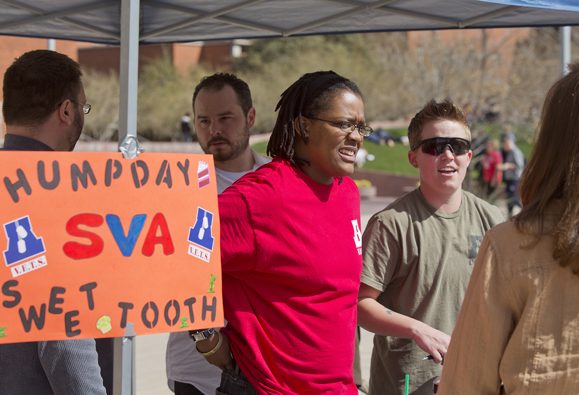
Women who are hesitant to show weakness while on active duty can be even more reluctant than men to seek help when they arrive on a college campus. Natasha Crawford, 31, a straight-A high school student, earned her diploma in 1999 and attended college for one year at Albany State University. Crawford followed in her father’s footsteps and enlisted in the Army, where she served from 2000 through 2009. Military service changed her, she says, especially deployment to Iraq during the initial ground war, which was “pretty rough” and “really scary.” She became irritable and earned the nickname Pit Bull. “I was drinking a lot,” she says. “I wasn’t sleeping.” Crawford’s way of coping was “to be tough and never show weakness. I did my job and took care of my soldiers,” she says. “I’ve never gone to seek the help that I need.”
She resumed her education, in 2009, at the University of Arizona. That first year was a period of adjustment. She slept with a gun by her bed and constantly scanned the environment for danger. This mindset, known as “hyper-vigilance,” is common among combat veterans. Sufferers tend to be uncomfortable in crowds, don’t like to be in classrooms with people at their backs, and prefer to sit near exits.
Crawford adjusted to college life, befriended non-veteran students, and in May she earned a bachelor’s degree in nutritional sciences. Still, the stress lingers. Sometimes Crawford “shuts down” or snaps at her partner, whom she married in March.
“Eventually I’ll do something about it,” she says.
